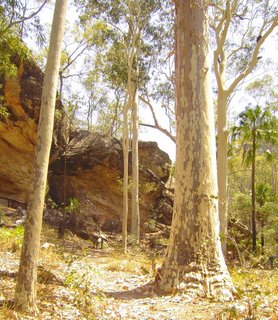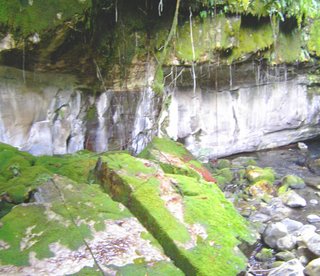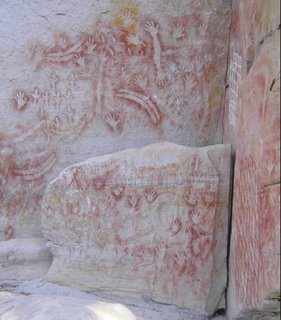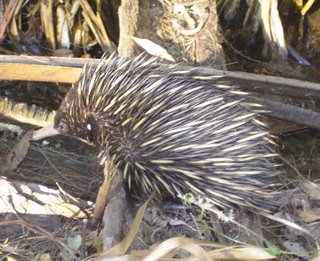 Carnarvon Gorge, And The Hunt For The Wild Platypus
Carnarvon Gorge, And The Hunt For The Wild PlatypusLeft: Aboriginal cave paintings at Baloon Cave. Interesting place!
 Left: Peeling Spotted Gum Tree.
Left: Peeling Spotted Gum Tree.The forest here is very noisy compared to the western U.S. With the wind blowing and the spotted gums peeling and the cabbage palms scratching and the lizards scampering and the parrots squawking and the kookaburras laughing, it's an amazing racket.
Very few people were in this park, midweek - 20 or so. Amazing, considering how crowded parks like Grand Canyon get in the U.S.!
There is an unconformity between permeable sandstone above and impermeable shale below in the Carnarvon Mountains. The result are many springs in the Canyon, generating that rarest and most valuable of all Australian commodities: permanent, fresh-flowing water. In Carnarvon Creek, untroubled for millions of years by growing continental-wide drought, lived that strangest of all of the world's animals, the platypus, with the famous designed-by-committee look. But it was a shy, secretive animal. Would I get to see one?
I walked west, up the canyon. The canyon wasn't that remarkable by western U.S. standards - bigger than Sycamore Canyon west of Nogales, Arizona, for example, but smaller than Sabino Canyon near Tucson. In general, Australia's mountains are much older than America's, and thus more-eroded and lower in elevation. Still, it wasn't the relief of the terrain that was of most interest - it was the unique wildlife, isolated here in the arid fastness of the world's driest continent.
I walked to the Moss Garden and the Aboriginal Art Gallery.
 Left: Moss Garden - permanent water at the sandstone/shale unconformity!
Left: Moss Garden - permanent water at the sandstone/shale unconformity! Left: Art Gallery. The daily concerns of Aboriginal life are all evident here: paired hunting boomerangs, painted three-toed emu and longer kangaroo footprints, ovals representing water-carrying bark baskets, hand prints and carved vulvas.
Left: Art Gallery. The daily concerns of Aboriginal life are all evident here: paired hunting boomerangs, painted three-toed emu and longer kangaroo footprints, ovals representing water-carrying bark baskets, hand prints and carved vulvas.I saw:
- Kangaroos:
- a water snake of some sort; and, most importantly,
- an echidna, or spiny ant-eater.
 Left: An echidna, or spiny anteater, one of the few animals in the world in the monotreme class, and one of Australia's strangest and most exotic of animals.
Left: An echidna, or spiny anteater, one of the few animals in the world in the monotreme class, and one of Australia's strangest and most exotic of animals.The ant-eater was very cute. When I stepped next to it, it would hide its head under a branch and freeze for a few seconds, like any sensible ant-eater should, but then resume snuffling for ants.
Since I didn't spend much time looking for the platypus, I never saw one. I didn't know exactly where they lived and so didn't want to cut into valuable hiking time looking fruitlessly in pools. Rumor had it one lived in the 'Rock Pool' near the Visitor's Center, but I got lost before I could look (damned Northern Hemisphere navigational instincts again!) in the Visitor's Center parking lot as the daylight swiftly vanished, and I almost failed to find the car before nightfall.
I kind of wanted to stay, but knew I'd have trouble getting back to Gatton by Thursday evening if I didn't leave, and besides, I had no authority to camp here, so I crawled out the same way I had come, on the bumpy dirt road.
No comments:
Post a Comment